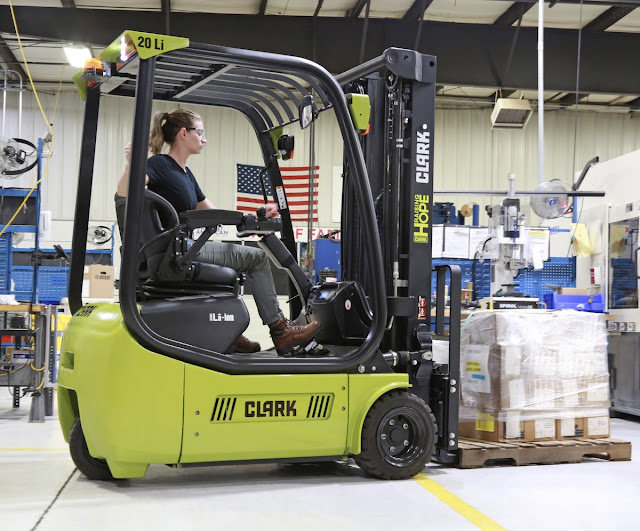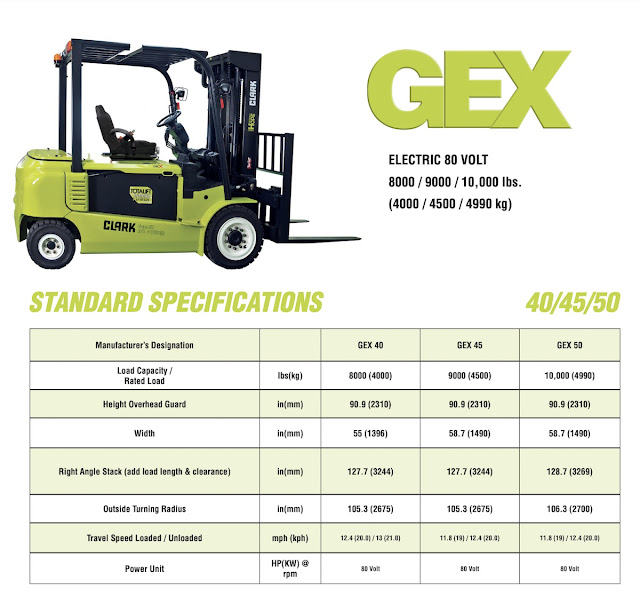Where can I get operator manuals and parts for my lift truck?
Operator's manuals, parts and service literature, and genuine service parts for your lift truck are available from your CLARK dealer. Please be prepared to provide the complete serial number to your dealer when ordering service literature and parts.
How can I locate my nearest CLARK dealer?
Click here to locate your local dealer using your State and County - https://www.clarkmhc.com/Home/DealerLookup
How old is my CLARK forklift?
Date of shipment information is available by sending an e-mail request to webmaster@CLARKmhc.com. Please provide the complete serial number of the forklift.
Where can I find the serial number on my CLARK lift truck?
The serial number is stamped into the serial number plate, which is usually located in the operator’s compartment on the hood or the instrument panel. If the serial number plate is missing or illegible, you can find the serial number stamped into the frame.

Depending on the age or model of the CLARK lift truck, you may find the serial number stamped into the frame exterior, the cowl exterior, or a fender.
Can I still get an operator's, parts, or manual for my old forklift?
Photo copies of CLARK operator's, parts, and service manuals are available for most older forklifts. Please send an e-mail request to webmaster@CLARKmhc.com for manual numbers and availability.

Please be sure to provide the complete serial number. Please know, however, that all operator's, parts, and service manuals must be ordered from your dealer
What are the prices of CLARK operator's, parts, and service manuals?
The prices of CLARK operators, parts, and service manuals vary. The price depends on the age of the lift truck and the size of the manual. Your dealer can provide this information to you
What is its average value for used CLARK lift truck?
Average values for used CLARK lift trucks are available from your dealer. CLARK Material Handling Company does not provide average value information for used lift trucks
Can I purchase manuals or parts for my forklift directly from CLARK?
CLARK manuals and service parts are available only from your dealer.
Can I access or download manuals for my lift truck directly from CLARK's website?
Manuals can not be accessed or downloaded from CLARK's website. Any manuals are available only from your dealer.
Where can I get a replacement serial number plate for my CLARK forklift?
A replacement serial number plate can be requested through your CLARK dealer. Please be prepared to provide the following information to your dealer:
- The complete CLARK forklift serial number.
- The type of lift truck upright (mast) if it has been changed.
- Any attachments or devices mounted on the lift truck.
- Any modifications made to the lift truck.
What is CLARK's position concerning the use of lift trucks as personnel elevators?
CLARK advises against the use of lift trucks as personnel elevators. Improper maintenance and operation of lift trucks or improperly designed platforms can cause accidents. CLARK's recommendation is to use equipment designed for the job.

CLARK's general-purpose lift trucks are not designed as personnel elevators. While the OSHA and ANSI safety standards permit such attachments to be used, CLARK does not itself sell safety platforms and does not permit the use of platforms on lift trucks. CLARK warns against the use of lift trucks for elevating people in its operator's manuals, in training courses and manuals, and in labels on the machines.
If you decide to use lift trucks as personnel elevators, be sure to review the OSHA and ANSI safety standards and procedures that must be followed in the course of such an application. In addition, please refer to the sections on personnel elevators contained in the CLARK's Employer's Guide to Material Handling Safety, especially the section on training necessary for operators of lift trucks used in this application. Please know that the Employer's Guide to Material Handling Safety is available from your dealer.
What should I know about operating lift trucks or other material handling equipment on grades, ramps, slopes, and inclines?
There are five basic points you should know for operating on grades:
- Use only equipment designed for operation on grades, such as sit-down lift trucks, stand-up counterbalanced lift trucks and pallet trucks. Narrow aisle and very narrow aisle trucks should not be used on grades.
- Stand-up counterbalanced trucks are appropriate for short grades, such as dock plates up to 15%, but are not to be used on long grades.
- Travel up and down grades slowly. Never turn on a grade or cross a grade sideways. Turn only on flat surfaces.
- In general, all lift trucks except pallet trucks should be operated with the load upgrade. Unloaded trucks should be operated with the forks or attachment downgrade. The load should be tilted back and raised only as high as necessary to clear the surface.
- When using pallet trucks, always keep forks downgrade and in the raised position when working on a grade. Do not ride pallet trucks on a grade. Pallet trucks are designed to travel up to a 5% maximum grade with load.
What is the difference between floor loading and wheel loading?
"Floor loading" is often a misunderstood term. It is a measurement of the amount of weight a floor can withstand under given load conditions. Only qualified architectural or civil engineers can determine floor loading. Wheel loading, the amount of weight carried on each wheel of an industrial truck, is one of the factors used to determine floor loading. “Wheel loading” is not synonymous with “floor loading.”
The Industrial Truck Association and the American Institute of Architectural Engineering agree that "Building construction varies widely, and it is impossible to make a precise recommendation without a detailed technical study of the building involved. It is always recommended that a qualified civil or architectural engineer study the building in question to determine the weight of the truck that would be permissible under the specific conditions involved." This is also the position of CLARK.
There is no simple rule or formula that will allow you calculate floor loads and you should not try to devise one. If floor loading stipulations are necessary, a civil or architectural engineer should compute them based on truck specification data available or provided by CLARK.
Wheel (or axle) loading data are supplied on specification sheets for current production CLARK models, as well as many older models. If you require floor loading information, however, it is your responsibility to have this done by a qualified civil engineer or architect.
CLARK current production model specification sheets provide front and rear axle weights in the both the loaded and unloaded condition, as well as tire information. This is all the information you will normally need for a civil engineer or architect to determine the suitability of a lift truck on a given floor or slab. This information applies to both cushion (solid) and pneumatic tire trucks.
Where can I get application information concerning my forklift?
Application information concerning your CLARK forklift is available from your dealer.
Where can I get specifications for my CLARK lift truck?
Specifications for a late-model CLARK lift truck are available from your dealer. Please be prepared to provide the complete serial number to your dealer.
Specifications for older lift trucks are available by sending an e-mail request to webmaster@CLARKmhc.com. Please provide the complete serial number.
Where can I get an MSDS sheet for a CLARK product?
MSDS (Material Safety Data Sheets) for CLARK products are available by sending an e-mail request to webmaster@CLARKmhc.com. Please provide the part number of the product.
How can I get a CLARK parts book that includes part numbers?
Custom Parts Books do not include part numbers. Parts are ordered from a dealer by providing the key number of the part desired and the truck serial number. However, if you require part numbers, a CLARK SPN (Specific Part Number) manual can be ordered from your dealer. Contact your dealer for details. Please be prepared to provide the complete serial number to your CLARK dealer
Where can I get parts and information for a forklift that has "RKF" in the serial number
CLARK "RKF" forklifts were manufactured in Korea in the late 1980s and early 1990s. These lift trucks were intended only for the Korean domestic market. However, third-party equipment companies have imported a number of "RKF" lift trucks into the U.S. For assistance with an "RKF" lift truck, please send an e-mail request to webmaster@CLARKmhc.com. Please provide the complete serial number.
Can I purchase a seat belt kit for my CLARK lift truck?
Operator restraint retrofit kits which include seat belts are available for many older CLARK lift trucks. Please contact your dealer for details.
Note: Due to their design, some older electric CLARK lift trucks cannot be fitted with a seat belt because the battery cannot be properly restrained. These electric lift trucks include the TW20/25, TM10/15S (24V), TM12/15S (48V), ECA17/30, EPA20/30, and early EC500-20/30 and EC500-30/55 trucks with ‘Y’ design overhead guards. Seat belts must not be installed on a electric lift truck if the battery cannot be properly restrained. CLARK does not install operator restraint retrofit kits free of charge.
An OSHA inspector told me that I needed to install an operator restraint on my older lift truck. What do I do if CLARK does not offer an operator restraint retrofit kit for my lift truck?
OSHA’s interpretation of standard number 1910.178 stipulates that an employer should take advantage of a manufacturer’s operator restraint retrofit program if one is offered. However, this stipulation does not apply if the lift truck manufacturer does not offer an operator restraint retrofit kit for the employer’s lift truck.
If CLARK does not offer an operator restraint retrofit kit for an older CLARK lift truck because the design prevents the operator restraint from being properly installed, the OSHA stipulation does not apply.
Comments
Post a Comment